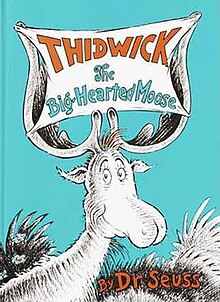Dr Seuss Characters Clip Art Thidwick the Big Hearted Moose Clipart
 | |
| Author | Dr. Seuss |
|---|---|
| Country | Us |
| Language | English |
| Genre | Children's literature |
| Publisher | Random House |
| Publication engagement | 1948 (renewed 1975) |
| Media type | Print (Hardcover) |
| Pages | 41 pages |
| ISBN | 0-394-90086-iii |
| OCLC | 1386296 |
| Preceded by | McElligot's Puddle |
| Followed by | Bartholomew and the Oobleck |
Thidwick the Large-Hearted Moose is a 1948 children's book by Dr. Seuss.
Summary [edit]
Thidwick, a moose in a herd numbering approximately sixty who subsist mainly on moose-moss and live on the northern shore of Lake Winna-Bango, grants a small problems'south request to ride on his antlers (mistakenly referred to in the book equally horns) gratuitous of charge. The bug takes advantage of the moose's kindness and settles in as a permanent resident, inviting various other animals to live on and in the moose'due south antlers.
The kind-hearted moose acquiesces to the unexpected living arrangements, treating the animals equally 'guests' fifty-fifty though he never told them explicitly that they were allowed to live there. Unfortunately, his passengers are thoughtless and selfish, and the situation quickly gets out of control. When one of the guests, a woodpecker, begins drilling holes in Thidwick'southward antlers, the other moose give Thidwick an ultimatum: if he doesn't get rid of his guests then he will be forced to exit the herd.
When Thidwick's sense of decency compels him to forgo the comforts of herd life in favor of indulging his guests, his herd leaves him backside. Winter comes, and the herd swims across the lake to detect fresh supplies of moose-moss. Thidwick wants to do the same, but his guests object, and insist that Thidwick must not take "their home to the far distant side of the lake." Even as he faces starvation, Thidwick refuses to go confronting his guests' wishes, and he remains on the common cold, northern shore of the lake, where his guests adopt to reside. Meanwhile, the heartless residents of Thidwick's antlers, who pay no regard to the increasing physical or psychological load that the moose is forced to endure, keep inviting other animals, including a 435 pounds (197 kg) blackness bear, to live with them.
The situation comes to a head when a group of hunters spot Thidwick and pursue him, with the goal of shooting him and mounting his head on the wall of the Harvard Social club of New York: a building well known in the 1930s and 1940s for its hunting trophies. Thidwick attempts to outrun the hunters, but the heavy load, including his passengers' refusal to permit him to travel across the lake, prevents him from escaping. Simply before his capture, however, Thidwick remembers that it is time for him to shed his antlers. At the last moment, he drops his antlers, makes a snide annotate to his former guests, and escapes by pond across the lake to rejoin his herd. His sometime guests are captured by the hunters and are blimp and mounted, notwithstanding perched on his antlers, on the trophy wall of the Harvard Club.
Pregnant [edit]
The story explores the limits of hospitality and sharing. Neil Reynolds has discussed information technology equally a parable of immigration issues and the social welfare state.[ane] Aeon J. Skoble discusses Thidwick at length equally an exemplification of the thought of holding rights, and particularly of John Locke'south formulation of property rights.[2] Skoble argues that Thidwick is badly mistaken in viewing the other animals as "guests", and that the story demonstrates this.[two] In a later essay in the same book, Henry Cribbs makes a similar bespeak, considering whether "Thidwick" is a example of squatter'due south rights.[iii] Co-ordinate to critic David Dempsey, "A man of less consistency than Seuss would take allow Thidwick be rescued past the creatures he is befriending ... but Seuss' logic is rooted in principle, rather than sentiment, and the sponging animals get what they deserve. Incidentally, this is too what the child expects."[4]
Adaptations [edit]
- Welcome, a 1986 Soviet animated pic
- Thidwick the Big-Hearted Moose, a 1992 direct-to-video brusque following Horton Hears a Who!
- Thidwick the Big-Hearted Moose, an upcoming animated special set up for release on Netflix.[5]
References [edit]
- ^ Neil Reynolds (27 Dec 2011), "The moose and the modern welfare land", The Globe and Post , retrieved 2013-01-30
- ^ a b Skoble, Aeon J (2011), "Thidwick the Big-Hearted Bearer of Holding Rights", in Held, Jacob Chiliad. (ed.), Dr. Seuss and Philosophy: Oh, the Thinks You Can Think!, Rowman & Littlefield, pp. 159–166, ISBN978-1442203112 , retrieved 19 June 2013
- ^ Cribbs, Henry (2011), "Whose Egg is it Really? Property Rights and Distributive Justice", in Held, Jacob K. (ed.), Dr. Seuss and Philosophy: Oh, the Thinks You Can Think!, Rowman & Littlefield, pp. 184–v, ISBN978-1442203112
- ^ Dempsey, David (11 May 1958). "The Significance of Dr. Seuss". The New York Times Book Review. p. 30.
- ^ Petski, Denise (March 15, 2022). "Netflix Orders Five Dr. Seuss-Inspired Blithe Preschool Series & Specials". Borderline . Retrieved March 15, 2022.
External links [edit]
- Thidwick the Large-Hearted Moose at Seuss Dude
- Thidwick, the Big-hearted Moose at Google Books
Source: https://en.wikipedia.org/wiki/Thidwick_the_Big-Hearted_Moose
0 Response to "Dr Seuss Characters Clip Art Thidwick the Big Hearted Moose Clipart"
Postar um comentário